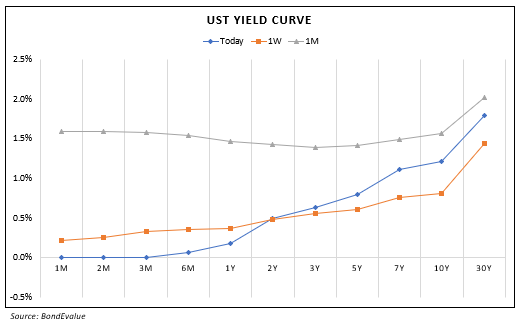This site uses cookies to provide you with a great user experience. By using BondbloX, you accept our use of cookies.
Bond Market News
US Treasury 2s10s Curve Steepens 5bp; Core PCE In-Line With Expectations
June 2, 2025

The US Treasury curve steepened on Friday, with the 2s10s spread widening by 5bp. Treasury Secretary Scott Bessent said that the US will never default, as the deadline for increasing the federal debt ceiling gets closer. He emphasised that bringing down the deficit is a slow process and they are going to do it over the next four years. Fed San Francisco President Mary Daly reaffirmed the March projections and expects two rate cuts before year end. The Fed remains in a wait-and-watch mode as it targets 2% inflation. Core PCE YoY for April came in at 2.5%, in line with expectations. Chicago PMI for May came in at 40.5, undershooting expectations of 45.1.
Looking at US equity markets, S&P closed flat while Nasdaq closed lower by 0.32%. Looking at credit markets, US IG and HY CDS tightened by 0.2bp and 0.6bp respectively. European equity markets closed mixed, with Euro Stoxx closing lower by 0.1% and FTSE100 closing higher by 0.64%. The iTraxx Main and Crossover CDS spreads widened by 0.1bp and 0.03bp respectively. Asian equity markets have opened in the red today, with the HSI down 2.6% at the time of writing. Asia ex-Japan spreads widened by 0.4bp.
New Bond Issues

Rating Changes
- Fitch Upgrades Shandong Hi-Speed Group to ‘A’; Outlook Stable
- Thomson Reuters Corp. Upgraded To ‘A-‘ On Solid Performance And Robust Growth Prospects; Outlook Stable
- Fitch Downgrades QVC to ‘CCC+’
- Moody’s Ratings Downgrades Estee Lauder to A3/P-2; outlook negative
- Volvo Cars Outlook Revised To Negative On Difficult Market Conditions; ‘BB+’ Rating Affirmed
Term of the Day: Dim Sum Bonds
These are bonds denominated in offshore Renminbi (CNH) and issued outside China (mostly in Hong Kong). The first dim sum bond was issued in 2007 by China Development Bank – a 2Y offshore RMB bond in Hong Kong, with a 3% coupon and size of RMB 5bn ($750mn). These instruments get their name from dim sum, a popular delicacy in Hong Kong. Dim sum bonds are typically issued by issuers that have a need for Renminbi but do not want to go through regulatory approvals as dim sum issuance are not subject to regulatory approval from mainland China or Hong Kong, provided that they are sold to professional investors.
Talking Heads
On Crack in the Bond Market is ‘Going to Happen’ – Jamie Dimon, JP Morgan Chase
“I just don’t know if it’s going to be a crisis in six months or six years, and I’m hoping that we change both the trajectory of the debt and the ability of market makers to make markets…I’m telling you it’s going to happen, and you’re going to panic. I’m not going to panic, we’ll be fine. We’ll probably make more money and then some of my friends will tell me that we like crises because it’s good for JPMorgan Chase — not really.”
On US Tax Cuts Risk Sparking New Market Bubble – Michael Hartnett, BoFA
“The flip in US economic strategy could incentivize traders to ditch bonds and pile back into artificial intelligence and crypto trades, which would risk inflating a market ‘bubble’…nothing screams bubble more than equities driving nominal/real yields higher”
On Untested Banks Finding Demand for Risky AT1 Bonds
Luca Evangelisti, Jupiter Asset Management
“Tighter spreads and a still relatively high cost of equity is why AT1s are preferred…Smaller banks may also be making the most of the current window in case spreads widen again…You don’t want to take excessive risk on small names to get that extra yield. Some could be especially at risk if there was a slowdown”
Jeremie Boudinet, Credit Mutuel Asset Management
“The primary market is very hectic and it seems like everybody wants to take part in anything… Demand is very strong, because liquidity is somewhat patchy on secondary markets”
Top Gainers and Losers- 02-Jun-25*
Go back to Latest bond Market News
Related Posts:









